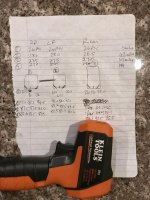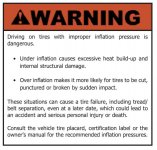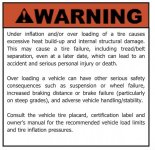I am not an expert on tire pressures, but I can read recommendations from expert organizations. I just read the U.S. Tire Manufacturers Association free publication titled, "Care and Service of Passenger and Light Truck Tires."
Excellent information! You can find it
here.
I did NOT realize how concerned they are about
UNDER inflated tires! You will read for yourself in multiple locations where they WARN of under inflated tires and the potential of internal damage from HEAT build up.
There are WARNING boxes through out the article like this:
View attachment 155891
Woah! It seems to me that if the US Tire Manufacture Association goes THIS FAR to make a consumer awareness article, they would say EXACTLY what they are concerned MOST with! In MANY locations it discusses how under-inflated tires is a great concern. Even in the big WARNING box above it says that! The warning box says over inflated tires can have higher chance of puncture. Hmmm.... What the heck?
Why would they have not listed traction control with higher pressurized tires in that warning box? (Maybe that isn't their primary concern!)
How does anyone truly KNOW if 14psi is NOT TOO low for these CAR tires on our MOTORCYCLES? Where does that number come from? Studies? Repeated cross-sectional analysis of rubber (natural, synthetic and filler)degradation and tire ply distortion? Or, somebody on an internet forum?
Wow. Now that I've read this entire article, I'm very concerned that too many of us may be under inflating our car tires on our motorcycle. I have no idea, but the US Tire Manufacturer Association has great concerns!
View attachment 155892
ANOTHER big warning box in the same article! It focuses on three things:
1.
Underinflation. Don't do it!
2.
Over loading the vehicle. That's unlikely with our Spyders.
3.
Consult the vehicle placard. Um.... we are using tires that BRP does NOT recommend! So, that makes it invalid, right?
Down below is the only reference that I found in the entire 54 page publication that mentions over inflation of a tire leading to reduced traction. BUT, how do we know what pressure these CAR TIRES have become OVER INFLATED on our MOTORCYCLE? Are we guessing, assuming, postulating, or examining? My guess is that it is a guess from some individuals on this forum. Granted, it can be an educated guess, but a guess nonetheless. Do you know the measurements for "traction" are done in a stopping straight line and NOT in cornering!
Things that make you go hhmmmmm...
Improper Tire Inflation
For optimum service, use the inflation pressures specifiedby the vehicle manufacturer on the vehicle tire placard,certification label or owner’s manual. Under inflation mayresult in rapid and/or abnormal tread wear, improper vehiclehandling and decreased fuel economy. Over inflation canalso result in rapid and/or abnormal tread wear, decreasedtraction and premature wear of suspension components.Improper tire inflation may cause a tire failure, includingtread/belt separation, even at a later date, which can leadto an accident and serious personal injury or death. Checkand adjust tire pressure (including the spare) at least onceper month with a pressure gauge (see “Proper Tire Inflation”on p. 11).
"Improper vehicle handling!" Wow... That's exactly what my butt felt when I tried putting my Yokohamas at 17psi. I even described it with what happened during a turn in an earlier post. It seems that the US Tire Manufactures Association may agree with my butt. LOL.
There was NO reference in the article (that I found) that warns over inflated tires cause heating and internal damage. Just toughness to puncture, and one reference to reduced traction. But, again, how do we know our psi's are putting the tire in an "over inflated" state?
Well, someone will postulate that the recommended tire pressures by the manufacturer should be followed. Um, OK. the manufacturer doesn't put these tires on our vehicles, AND there are plenty of reasons why that recommended inflation amount MAY NOT be the optimal tire pressure. They can be influenced by other things besides performance. That's another easy internet search away for those that want to read.
So, my take on reading this article is that LOW PSI tire users should REALLY monitor their heat build-up. It can degrade the tire components internally, and you may not realize it.




